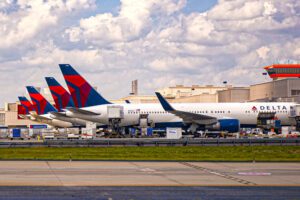At JFK airport, an AA plane crossed the runway on which a Delta jet was taking off. Alert air traffic controllers prevented a deadly collision. Poor FAA plane incident data leaves more questions than answers.

After the incident, the Delta flight was canceled, but the American flight flew on to London and was only 13 minutes late. FAA plane incident data left many questions unanswered.
While a deadly collision was prevented, because of poor FAA plane incident data many questions need to be asked in the aftermath.
I’ve got many questions about how the incident occurred and how it was handled in the aftermath of the near collision, but before we start asking questions, let’s review exactly what happened.
Delta’s flight 1943, a Boeing 737, was headed for the Dominican Republic. American’s flight 106, a Boeing 777, was headed to London. The incident occurred at about 8:45 pm.
So, what happened at JFK?
The Delta flight was waiting at the end of JFK’s Runway 4L for permission to take-off. At JFK, Runway 4L and Runway 31L intersect. While the Delta 737 was getting ready to take off, the American 777 was taxiing, according to recorded publicly available radar reports, when it neared the intersection of runways 4L and 31L.
An air traffic controller told the American 777 to cross Runway 31L, not Runway 4L, where the Delta flight was to take off, saying,
“American 105 heavy, cross Runway 31L at Kilo.”
The American pilot confirmed,
“31L at Kilo, American 106 heavy.”
Almost at the same time, another air traffic controller told the Delta jet that it was cleared for takeoff,
“Delta 1943, wind 350 18 gusts 24, Runway 4L, cleared for takeoff.”
The Delta pilot confirmed,
“Cleared for take off Runway 4L, Delta 1943.”
As the Delta flight was taking off, the American flight turned onto the wrong runway and crossed in front of the Delta plane rumbling down the runway.
Meanwhile, with the Delta flight starting their takeoff, the recorded ground radar shows American 106 jogging left then right, then heading for Runway 4L, instead of turning right to cross Runway 31L, as instructed.
About 20 seconds later, the air traffic controllers looking out at JFK’s runways and reading the ground radar desperately attempted to avoid the crash they saw unfolding. First, they called the Delta flight saying,
“Shit! Delta 1943 cancel takeoff clearance. Delta 1943 cancel takeoff clearance.”
The Delta 1943 pilot responded,
“Rejecting.”
Another air traffic controller called the American flight, saying,
“American 106 heavy, American 106 heavy, hold position. American 106 heavy, hold position.
The Delta flight stopped just six seconds from disaster.

Moments later you can hear the Delta pilot expressing huge relief saying,
“All right and un…phew. Delta 1943.”
A short time later, an air traffic controller contacted the American flight,
“American 106 heavy, possible pilot deviation. I have a number for you, advise ready to copy.”
The American pilot comes back,
“Ready to copy. Go ahead sir.”
Eventually, the American pilots began to determine that they had steered their big jet onto the wrong runway.
After being told to be on standby, an American pilot asked air traffic control,
“The last clearance we were given, we were cleared to uh cross, is that correct?”
Apparently, it was beginning to dawn on the American pilots that they had likely made a major mistake.
That’s what we can piece together from both publicly available radar, courtesy of flightradar24, and the air traffic recordings from LiveATC.net, courtesy of AirlineGeeks.
While we likely know how the near miss occurred, there remain many questions about what happened to cause the possible disaster, how the potential collision could have been avoided and more questions about what happened after the incident and why it was permitted.
I’ve got critical questions the FAA and the NTSB must answer after this near-miss.
Here are my questions, all of which remain unanswered at this point.
1. How could an experienced captain (American) have taxied and crossed the wrong runway, particularly an active runway on which another plane was taking off?
2. The air traffic controller was clear, stating, “American 106 heavy, cross Runway 31L at Kilo.” How could none of the three pilots on the American Boeing 777 not notice that their jet was going the wrong way, about to cross the wrong runway? That gives me great pause. The Delta pilots aborted the flight to London. Their reactions after the near accident were clearly shaken.
After its takeoff was aborted, the Delta flight returned to the gate and the flight was delayed until the next day. The AA flight soon departed from JFK and arrived at London Heathrow Airport early.
3. Wasn’t it likely that the American pilots were similarly shaken, even if we can’t tell from their conversation with air traffic control? Wouldn’t it have been far more prudent if American Airlines decided to delay the flight to London and at least bring on a new flight crew?
4. In addition, with the American flight resuming, it’s likely that the cockpit tape that recorded the conversation between the pilots during the incident is gone forever. The flight from JFK to Heathrow took about seven hours. But the cockpit recorder retains just two hours of recordings. That’s a major loss to the National Transportation Safety Board (NTSB) investigator. Why is there no rule preventing such a loss of data?
5. With the American flight resuming, not that the pilots would necessarily lie to investigators, by resuming the flight, the pilots had plenty of time to talk about the incident with each other, which could alter their recollection when questioned by NTSB investigators. Shouldn’t the flight crew be required to stand-down and wait for NTSB questioning?
6. Why isn’t it standard FAA and NTSB procedure that the flight crews and the planes aren’t immediately grounded when an incident like this happens? That would give NTSB investigators access to the cockpit recorders before they could be overwritten. That would give NTSB investigators access to the flight crew while the incident is fresh in their minds. It would allow NTSB investigators to separate flight crew members soon after the incident to prevent them from conferring about it.
The NTSB must determine what happened at JFK and how to better ensure their future investigations into near misses will be able to determine what happened.
During the NTSB investigation, the agency must accomplish two tasks. They must determine what went wrong so that it can be prevented in the future. They must also determine what changes in FAA and NTSB procedures are necessary to ensure that all the evidence potentially explaining the incident is preserved and maintained, as well as ensure that all salient testimony remains well preserved and will be made as honestly as possible.

READ ALSO:
Car rental customers shocked by EV charges
Airline customer service commitments — are they worthless?
After many years working in corporate America as a chemical engineer, executive and eventually CFO of a multinational manufacturer, Ned founded a tech consulting company and later restarted NSL Photography, his photography business. Before entering the corporate world, Ned worked as a Public Health Engineer for the Philadelphia Department of Public Health. As a well known corporate, travel and wildlife photographer, Ned travels the world writing about travel and photography, as well as running photography workshops, seminars and photowalks. Visit Ned’s Photography Blog and Galleries.


